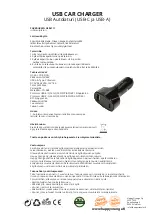
There is a possibility that the Active Lane Keep-
ing Assist could misjudge the given traffic sit-
uation. An inappropriate brake application may
be interrupted at any time if:
R
you steer slightly in the opposite direction
R
you switch on the turn signal
R
you clearly brake or accelerate
A lane-correcting brake application is interrup-
ted automatically if:
R
a driving safety system intervenes, such as
ESP
®
, PRE-SAFE
®
Brake or Active Blind Spot
Assist
R
lane markings are no longer detected
Activating Active Lane Keeping Assist
X
Activate Active Lane Keeping Assist using the
on-board computer; to do so, select
Stand‐
Stand‐
ard
ard
or
Adaptive
Adaptive
(
Y
page 291).
If you drive at speeds above 60 km/h and lane
markings are detected, the lines in the assis-
tance graphic display (
Y
page 290) are
shown in green. Active Lane Keeping Assist is
ready for use.
If
Standard
Standard
is selected, no warning vibration
occurs if:
R
you have switched on the turn signals. In
this event, the warnings are suppressed for
a certain period of time.
R
a driving safety system intervenes, such as
ABS, BAS or ESP
®
.
When
Adaptive
Adaptive
is selected, no warning vibra-
tion occurs if:
R
you have switched on the turn signals. In
this event, the warnings are suppressed for
a certain period of time.
R
a driving safety system intervenes, such as
ABS, BAS or ESP
®
.
R
you accelerate hard, e.g. kickdown.
R
you brake hard.
R
you steer actively, e.g. swerve to avoid an
obstacle or change lane quickly.
R
you cut the corner on a sharp bend.
Towing a trailer
If you couple up a trailer, make sure that you
have correctly established the electrical con-
nection. This can be accomplished by checking
the trailer lighting. Lane-correcting brake appli-
cation does not take place when towing a trailer.
Active Lane Keeping Assist is not activated and
the lines in the assistance graphic are grey.
Off-road driving systems
4MATIC (permanent all-wheel drive)
4MATIC ensures that all four wheels are perma-
nently driven. Together with ESP
®
and 4ETS, it
improves the traction of your vehicle whenever
a drive wheel spins due to insufficient grip.
If you fail to adapt your driving style, 4MATIC can
neither reduce the risk of an accident nor over-
ride the laws of physics. 4MATIC cannot take
account of road, weather and traffic conditions.
4MATIC is only an aid. You are responsible for
the distance to the vehicle in front, for vehicle
speed, for braking in good time and for staying in
lane.
!
Never tow the vehicle with one axle raised.
This may damage the transfer case. Damage
of this sort is not covered by the Mercedes-
Benz implied warranty. All wheels must
remain either on the ground or be fully raised.
Observe the instructions for towing the vehi-
cle with all wheels in full contact with the
ground.
!
A function or performance test should only
be carried out on a twin-axle dynamometer.
Before you operate the vehicle on such a
dynamometer, please consult a qualified
workshop. You could otherwise damage the
drive train or the brake system.
i
In wintry driving conditions, the maximum
effect of 4MATIC can only be achieved if you
use winter tyres (M+S tyres), with snow
chains if necessary.
Further information about "Driving off-road"
(
Y
page 199).
DSR (Downhill Speed Regulation)
General notes
DSR is an aid to assist you when driving down-
hill. It keeps the speed of travel at the speed
selected on the on-board computer. The steeper
the downhill gradient, the greater the DSR brak-
ing effect on the vehicle. When driving on flat
stretches of road or on an uphill gradient, the
DSR braking effect is minimal or non-existent.
DSR controls the vehicle’s speed when it is acti-
vated and the transmission is in position D, R or
N. By accelerating or braking, you can always
drive at a higher or a lower speed than that set
on the on-board computer.
252
Driving systems
Dr
ivi
ng
an
d
parki
ng
















































